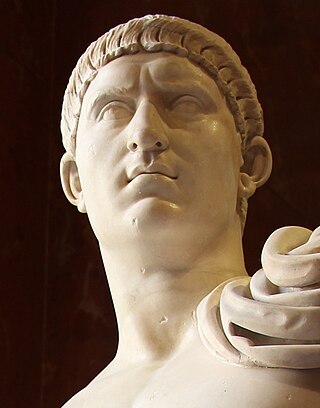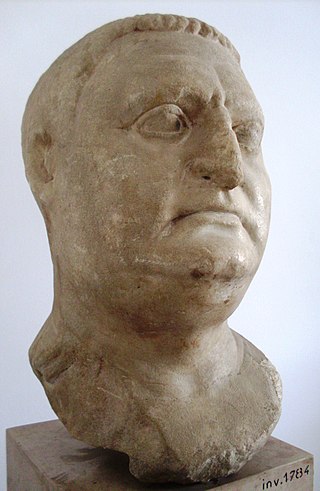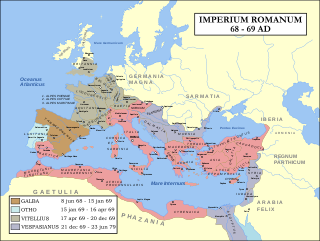Related Research Articles

Galba was Roman emperor, ruling from AD 68 to 69. He was the first emperor in the Year of the Four Emperors and assumed the throne following Emperor Nero's suicide.

Otho was Roman emperor, ruling for three months from 15 January to 16 April 69. He was the second emperor of the Year of the Four Emperors.

Aulus Vitellius was Roman emperor for eight months, from 19 April to 20 December AD 69. Vitellius was proclaimed emperor following the quick succession of the previous emperors Galba and Otho, in a year of civil war known as the Year of the Four Emperors. Vitellius was the first to add the honorific cognomen Germanicus to his name instead of Caesar upon his accession. Like his direct predecessor, Otho, Vitellius attempted to rally public support to his cause by honoring and imitating Nero who remained widely popular in the empire.

AD 69 (LXIX) was a common year starting on Sunday of the Julian calendar. In the Roman Empire, it was known as the Year of the consulship of Galba and Vinius. The denomination AD 69 for this year has been used since the early medieval period, when the Anno Domini calendar era became the prevalent method in Europe for naming years.

The 60s decade ran from January 1, AD 60, to December 31, AD 69.

Gaius Suetonius Paulinus was a Roman general best known as the commander who defeated the rebellion of Boudica.

The Year of the Four Emperors, AD 69, was the first civil war of the Roman Empire, during which four emperors ruled in succession: Galba, Otho, Vitellius, and Vespasian. It is considered an important interval, marking the transition from the Julio-Claudians, the first imperial dynasty, to the Flavian dynasty. The period witnessed several rebellions and claimants, with shifting allegiances and widespread turmoil in Rome and the provinces.
Aulus Caecina Alienus was a Roman general active during the Year of the Four Emperors.
Marcus Vettius Bolanus was a Roman senator and soldier. He was suffect consul for the nundinium of September-December 66 as the colleague of Marcus Arruntius Aquila.
Gaius Licinius Mucianus was a Roman general, statesman and writer. He is considered to have played a role behind the scenes in the elevation of Vespasian to the throne.
Titus Flavius T. f. T. n. Sabinus was a Roman politician and soldier. A native of Reate, he was the elder son of Titus Flavius Sabinus and Vespasia Polla, and brother of the Emperor Vespasian.

Galeria Fundana was a Roman empress, the second wife of Roman emperor Vitellius.
Lucius Salvius Otho Titianus was the elder brother of the Roman Emperor Otho. As a Roman senator, he was consul in the year 52 as the colleague of Faustus Cornelius Sulla Felix, and appointed consul as his brother's colleague for the period from Galba's murder to the end of February. Titianus was given the daily responsibilities of the emperor by Otho when Otho left Rome to halt the advance of Vitellius into Italy. Subsequently, Titianus was appointed generalissimo in charge of the war by Otho and was present at the First Battle of Bedriacum.
The gens Vitellia was a family of ancient Rome, which rose from obscurity in imperial times, and briefly held the Empire itself in AD 69. The first of this gens to obtain the consulship was Aulus Vitellius, uncle of the emperor Vitellius, in AD 32.
The gens Galeria was a Roman family of Imperial times. The family first rose to prominence under the Julio-Claudian dynasty, but the most illustrious person of the name was the emperor Galerius, one of the heirs of Diocletian, who reigned from AD 305 to 311, although he cannot have been a direct descendant of the earlier family.
Aulus Marius Celsus was a Roman senator who held several offices in the emperor's service during the first century AD, as well as playing a role in the Year of Four Emperors. He was suffect consul of the nundinium of July to August 69 as the colleague of Gnaeus Arrius Antoninus.
Aulus Ducenius Geminus was a Roman senator active in the first century AD. Geminus is best known as Galba's appointment as Urban prefect of Rome during the Year of Four Emperors.
Appius Annius Gallus was a Roman senator and general who flourished during the first century. He held the office of suffect consul in 67 with Lucius Verulanus Severus as his colleague. The suffect consul of 67 is commonly identified as the general who supported Otho during the Year of the Four Emperors.
Gaius Galerius was a Roman eques who was active during the reign of Tiberius. He is best known as the praefectus or governor of Egypt (16-32).

Vitellia was a Roman noblewoman, who was the daughter of the emperor Aulus Vitellius and was married to the Roman senator Decimus Valerius Asiaticus. A fictionalised Vitellia is a central character in the opera La clemenza di Tito by Mozart.
References
- ↑ Paul A. Gallivan, "Some Comments on the Fasti for the Reign of Nero", Classical Quarterly , 24 (1974), pp. 292, 311
- ↑ Institutes 10.1.119
- ↑ William Dominik; Jon Hall (11 January 2010). A Companion to Roman Rhetoric. John Wiley & Sons. p. 511. ISBN 978-1-4443-3415-9.
- ↑ Werner Eck, "Galerius (4)", Brill's New Pauly, Volume 4 (Stuttgart:Metzler, 1998), Col. 758 ISBN 3-476-01474-6
- ↑ Gwyn Morgan, 69 A.D., the Year of Four Emperors (Oxford: University Press, 2006), p. 77
- ↑ CIL V, 5812
- ↑ Tacitus Histories I.90.2
- ↑ Tacitus, Histories, II.60
- ↑ Werner Eck, "Jahres- und Provinzialfasten der senatorischen Statthalter von 69/70 bis 138/139", Chiron , 12 (1982), p. 300